For you
Osteopathy can treat a range of musculoskeletal problems offering effective pain relief for issues such as back pain, joint pain, headaches & muscular strains. Please take a look below at the various conditions osteopaths are able to treat.
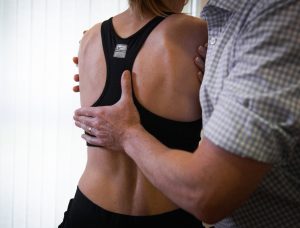
Back Ache
Back pain is extremely common – over six million patients visit osteopaths each year, and back pain accounts for over 50% of those cases.
Pain exists for a reason. Your back will tell you very quickly when things aren’t right, because the longer spinal faults go unchecked, the more widespread the strain suffered by the skeleton as a whole. The role of pain is to make us aware of the fault, so I can help fix the problem.
Most people will suffer with back pain at some point in their life. It can vary from a minor niggling ache to a severe incapacitating pain that can spread to other areas of the body.
Causes of back pain include:
- Chronic postural problems
- Unsuitable seating
- Unsupportive beds
- Inappropriate lifting
- A sedentary lifestyle
- Stress and anxiety
- Accidents
- Sports injuries
- Pregnancy
- Obesity
The cure for an aching back lies in persuading stiff and painful spinal joints to move, while at the same time stretching and strengthening the surrounding soft tissues to create control and stability in the back. This is something I specialise in by helping you to understand, isolate the source of the problem, treat the pain, and give you advice on how to prevent it from recurring.
To learn more, or to make an appointment, please phone or email one of our clinics.
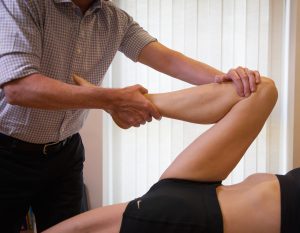
Sciatica
Sciatica is pain in the leg, usually caused by back problems, and occurs when something blocks the path of the spinal nerve on its way out of the spinal column.
Most back pain is a simple joint problem – the back’s equivalent, you might say, of a twisted ankle – but when the problem persists, the swollen joint can irritate the nearby spinal nerve. Degeneration of the inter-vertebral disc can have the same result.
Another type of leg pain is called ‘referred’ pain. When a joint becomes inflamed and painful, its nerve supply picks up the pain messages and pain is felt in the back. However, other tissues sharing the same nerve supply as the inflamed joint may also feel pain. It could be the sensation to the skin of the lower leg giving you a vague nagging pain in the buttock, hip or leg, far removed from the back itself. So, the back is the problem, and the pain in the leg is the symptom.
Conditions that cause sciatica include:
- A herniated or slipped disc that causes pressure on a nerve root – this is the most common cause of sciatica.
- Piriformis syndrome – this develops when the piriformis muscle, a small muscle that lies deep in the buttocks, becomes tight or spasms, which can put pressure on and irritate the sciatic nerve.
- Spinal stenosis – this condition results from narrowing of the spinal canal with pressure on the nerves.
- Spondylolisthesis – this is a slippage of one vertebra so that it is out of line with the one above it, narrowing the opening through which the nerve exits
Whatever the cause of your pain, I can help bring relief by identifying the root of the problem and treating the source of the discomfort.
If I feel further investigation may be necessary to find the root cause of your sciatic symptoms, then I will refer you on to the appropriate specialist, who may carry out some form of diagnostic imaging, for example, an MRI or Xray.
To learn more, or to make an appointment, please call or email one of our clinics.
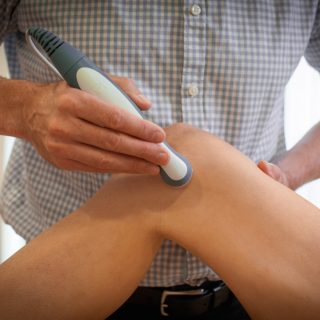
Lower body joint pains
(Hip, Knee, Ankle & Foot)
Hip
Hip pain doesn’t always indicate a problem with the hip itself. The body’s nervous and circulatory systems are closely linked, meaning pain in your hip or groin may actually originate from your lower back, or even a muscular spasm in the gluteal region. On the other hand, there may be a problem within the hip joint itself, such as osteoarthritis.
Some of the causes of hip pain include:
- Arthritis – osteoarthritis, rheumatoid artiritis, psoriatic arthritis, juvenile rheumatoid arthritis (children)
- Injuries – bursitis, hip dislocation, hip fracture, labral tears, inguinal hernia, tendonitis, sprains and strains
- Pinched nerves – sciatica, spinal stenosis, herniated disc, sacroiliitis
Performing various forms of functional, active and passive testing can help to determine the source of pain in your hip.
Depending on what may be causing the problem, a specific treatment plan can be devised, which may involve further diagnostic imaging, osteopathic treatment to the appropriate areas along with a stretching and strengthening exercise programme that may be carried out in our clinics and at home.
Knee
Knee pain indicates a problem that may be occurring in or around your knee joint. Knee pain can be initiated by specific problems with the knee joint itself, or it may be due to problems affecting the soft tissues, for example, ligaments, tendons or bursae, that surround the knee.
There are so many different conditions that may affect the knee so it is important to seek help if you are concerned about the pain you are experiencing.
The degree to which someone may suffer knee pain can vary enormously. Some people may feel only a minor twinge, while others may be subjected to unbearable pain that restricts their normal day-to-day activities. In a lot of cases, osteopathic treatment and self-help means are all you need to help you cope with knee pain.
As mentioned with the hip above, I am able to build a tailor made treatment plan for you in order to help relieve any pain you may be experiencing in or around your knee.
To learn more, or to make an appointment, please phone or email one of our clinics.
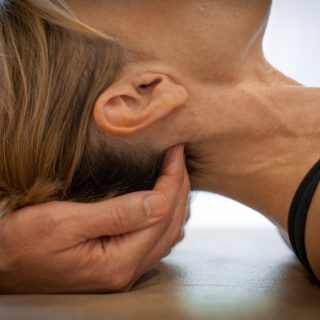
Neck ache and whiplash
Many neck problems are the result of modern life and the continuous strain we place on our bodies. Neck pain is a very common problem, affecting about 10 percent of the adult population at any single point in time and it can range from a dull ache to an intense, sharp type of sensation.
You may experience symptoms that accompany your neck pain, e.g. numbness or muscle weakness, and these may help help identify the cause of your pain.
Headaches frequently accompany neck pain, and are caused by a build-up of muscular tension across the shoulder, which travels up into the base of the skull.
Most neck pain doesn’t last particularly long, maybe a few hours or days, but pain that continues longer than a few weeks is regarded as chronic. This type of neck pain usually responds well to a course of osteopathic treatment.
There are many causes of neck pain but the majority of causes include:
- Poor posture – from sitting slumped at work or home
- Osteoarthritis/Rheumatoid Arthritis
- Carry heavy bags on one shoulder
- Sleeping on your stomach with too many or too few pillows
- Disc herniation
- Whiplash from a trauma
- Tension headaches
- Fibromyaligia
- Cradling you phone between your neck and shoulder
- Emotional stress
Pain in the neck and mid-back can also result from trauma, especially car accidents, which can lead to problems weeks, months or even years later.
As an osteopath, I can help determine the cause of your symptoms and suggest a
course of treatment to overcome your pain.
Headaches arising from neck and jaw problems
Headaches affect most of us at some point in our lives. While painkillers can help to alleviate the symptoms, they don’t address the cause of the pain.
You may not have considered osteopathic treatment for recurring headaches, but the fact is that some types of headache respond very well, and I successfully treat many people for headaches.
There are many reasons why people suffer with headaches, including diet, stress, and chemical imbalances. Tension or cervicogenic headaches arising from the neck and jaw can often be alleviated by a course of treatment.
I can help you determine whether your condition can be treated with osteopathy and, if so, devise a treatment plan to help you.
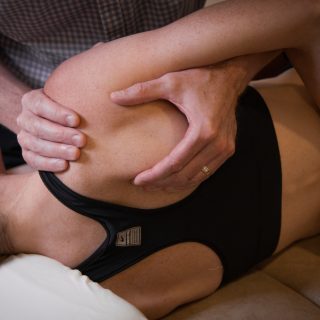 Upper body joint pains (Shoulder, Elbow, Wrist & Hand)
Upper body joint pains (Shoulder, Elbow, Wrist & Hand)
Shoulder
Not all shoulder problems arise from the shoulder itself, particularly where there is no history of trauma to the area. Shoulder pain includes any pain that arises in or around your shoulder. Your pain may stem from the actual joint itself, or from any adjoining muscles, ligaments or tendons (of which there are many!) Shoulder pain is generally exacerbated when actively moving your arm or shoulder.
It must be noted that there are also specific conditions that affect organs in your chest or abdomen, for example, gallbladder disease or heart disease, and these may instigate shoulder pain too. This type of shoulder pain is known as ‘referred pain.’ If movement does not aggravate your shoulder pain, then it is possible that you may have ‘referred pain’ from elsewhere.
There are also other musculoskeletal conditions, unrelated to the shoulder, which can cause referred pain in the shoulder region. These may include neck dysfunctions, repetitive strain injuries, tennis/golfer’s elbow and carpal tunnel syndrome.
Causes of specific shoulder pain include:
- Bursitis
- Dislocated shoulder
- Frozen shoulder
- Rotator Cuff
- Impingement Syndrome
- Sprains and strains
- Osteoarthritis
- Polymyalgia rheumatica
- Rheumatoid arthritis
- Tendinitis/tendon rupture
- Torn cartilage
I can help determine the source of your discomfort and create a personalised treatment plan to relieve the symptoms.
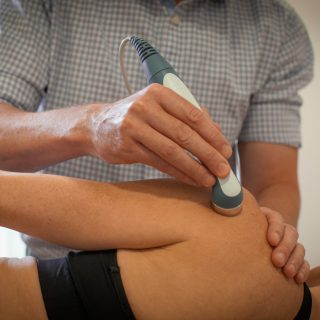
Work-related aches and pains
Work, whether at a computer terminal or in heavy industry, can cause disorders of muscles, tendons and joints, particularly in the back, neck, hands and arms. Symptoms vary from mild aches and pains to severe pain and disability. These may be caused by:
Manual handling and lifting:
- Muscle and tendon injuries
- Intervertebral disc lesions (‘slipped disc’)
- Sciatica
Forceful or repetitive movements:
- Carpal tunnel syndrome
- Tenosynovitis
- Peritendinitis
- Epicondylitis (tennis elbow)
- Mouse wrist
Poor posture and repetitive movements:
- Low back pain
- Neck and shoulder pain
- Computer hump
- Repetitive strain injuries
I can help to successfully treat many work-related conditions and can provide specific guidance on workstation set up along with preventative exercise advice in order to avoid problems recurring in the future.
Muscle Spasms
Muscular tension is extremely common nowadays, mainly due to the physical and mental stresses we place on our bodies on a daily basis, from both work and home life.
If this tension isn’t addressed properly early on, it may become prolonged and build up within the body, resulting in a chronic problem that can cause pain in certain joints and surrounding tissues. Taut muscles can pull the joints out of alignment, which leads to abnormal joint function and potential pain.
Osteopathic techniques help to reduce this tension using soft tissue massage, manipulation and gentle stretching before addressing the cause of the tension itself.
To learn more, or to make an appointment, please phone or email one of our clinics.
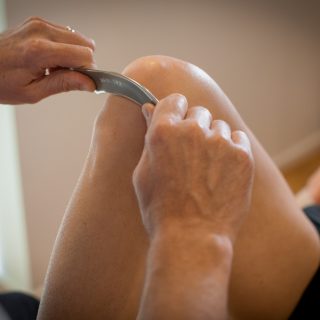
Arthritic and rheumatic pain
All of us beyond our twenties experience certain degenerative changes within our joints, due mainly to the limited way we use our bodies in today’s society.
This degeneration speeds up the ageing of our joints, and older joints are less tolerant of adverse stresses and strains.
Arthritis is not a disease, but simply wear and tear: it only begins to cause pain once it has become more advanced.
Degeneration of the joints happens when the flow of fluid into the joint slows down – cartilage becomes brittle, ligaments, tendons and muscles dry out and lose their elasticity, and the joints lose their ‘give and take’.
If this process continues unchecked, the cartilage can become chipped and irregular, and weight bearing through the joint becomes uneven. This, in turn leads to abnormal bony outgrowths being formed around the edges of the joint, and the joint then swells.
The pain is caused by mechanical and chemical irritation of all the tissues of the joint. Mechanical irritation arises when the joint’s soft tissues are stretched, often by excess fluid trapped in the joint.
Chemical irritation is caused by the effect of ‘inflammatory products’ produced by the abnormal tissues. The good news is that I can help control the pain by performing simple techniques to drain away the excess fluid and free up the stiff, worn-out joints.
This helps to rejuvenate any soft tissues that are binding a joint too tightly: it may even be possible for such movement to stimulate new cartilage growth. At the same time I can stretch and release the fibrous, older soft tissues that surround the joint – which coincidentally become thicker and stiffer with lack of activity over time – helping to ease pain and rejuvenate the joint itself.
My skill lies in using therapeutic techniques to mobilise degenerate joints and stretch the surrounding soft tissues, rather than pushing the debilitated joint too hard too soon, risking further damage.
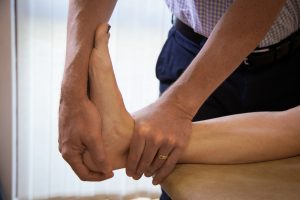 Minor sport injuries
Minor sport injuries
Sports injuries are one of my specialities. They tend to arise either from a specific trauma or accident, such as a bad tackle or a collision, not warming up correctly prior to exercising, using inappropriate/defective equipment or overtraining (where an increase in functional demand is placed upon a fatigued joint or soft tissue that isn’t functioning properly). This can cause muscle/pelvic imbalances, poor posture and altered spinal mechanics that can lead to any of the following:
• Shoulder impingement syndrome
• Tennis or golfer’s elbow
• Ligament sprains/muscle strains
• Cartilage tears
• Patella or Achilles tendinitis
Overuse injuries are common in professional athletes because of the intensity of their training.
Children are also at risk of developing overuse injuries, so in order to diminish the chance of injury occurring they should be encouraged to play a wide range of sports, and have any training supervised by an experienced coach.
Not all sports injuries can be prevented, but injury risk can be reduced by:
• Warming up properly prior to exercising
• Know your limits when training
• Using specific safety equipment for certain sports, such as shinpads for football or a gum shield for rugby
• Receiving sport specific coaching to learn correct techniques
If you’ve suffered a sporting injury, I can help to speed up your recovery time using various techniques including ultrasound, electrotherapy, shockwave and medical acupuncture.
I can also highly recommend a rehabilitation programme to reduce the risk of problems in the future.
Many sports people who visit our clinics, from amateurs to top professionals, have found that my osteopathic care has led to a significant improvement in their performance and a reduction in the occurrence of injury.

